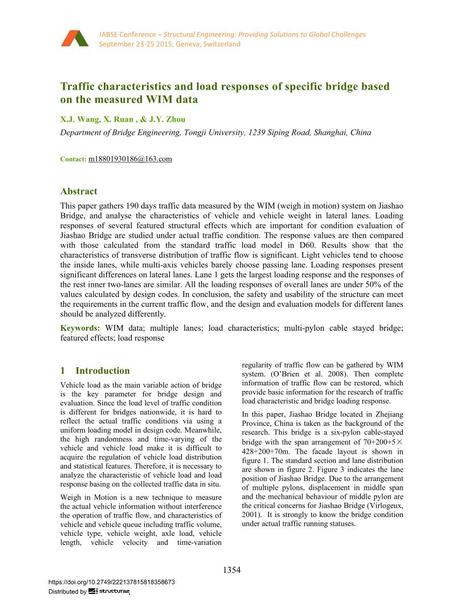Traffic characteristics and load responses of specific bridge based on the measured WIM data

|
|
|||||||||||
Bibliografische Angaben
| Autor(en): |
Xuejing Wang
(Department of Bridge Engineering, Tongji University, 1239 Siping Road, Shanghai, China)
Xin Ruan (Department of Bridge Engineering, Tongji University, 1239 Siping Road, Shanghai, China) |
||||
|---|---|---|---|---|---|
| Medium: | Tagungsbeitrag | ||||
| Sprache(n): | Englisch | ||||
| Tagung: | IABSE Conference: Structural Engineering: Providing Solutions to Global Challenges, Geneva, Switzerland, September 2015 | ||||
| Veröffentlicht in: | IABSE Conference Geneva 2015 | ||||
|
|||||
| Seite(n): | 1354-1359 | ||||
| Anzahl der Seiten (im PDF): | 6 | ||||
| Jahr: | 2015 | ||||
| DOI: | 10.2749/222137815818358673 | ||||
| Abstrakt: |
This paper gathers 190 days traffic data measured by the WIM (weigh in motion) system on Jiashao Bridge, and analyse the characteristics of vehicle and vehicle weight in lateral lanes. Loading responses of several featured structural effects which are important for condition evaluation of Jiashao Bridge are studied under actual traffic condition. The response values are then compared with those calculated from the standard traffic load model in D60. Results show that the characteristics of transverse distribution of traffic flow is significant. Light vehicles tend to choose the inside lanes, while multi-axis vehicles barely choose passing lane. Loading responses present significant differences on lateral lanes. Lane 1 gets the largest loading response and the responses of the rest inner two-lanes are similar. All the loading responses of overall lanes are under 50% of the values calculated by design codes. In conclusion, the safety and usability of the structure can meet the requirements in the current traffic flow, and the design and evaluation models for different lanes should be analyzed differently. |
||||
